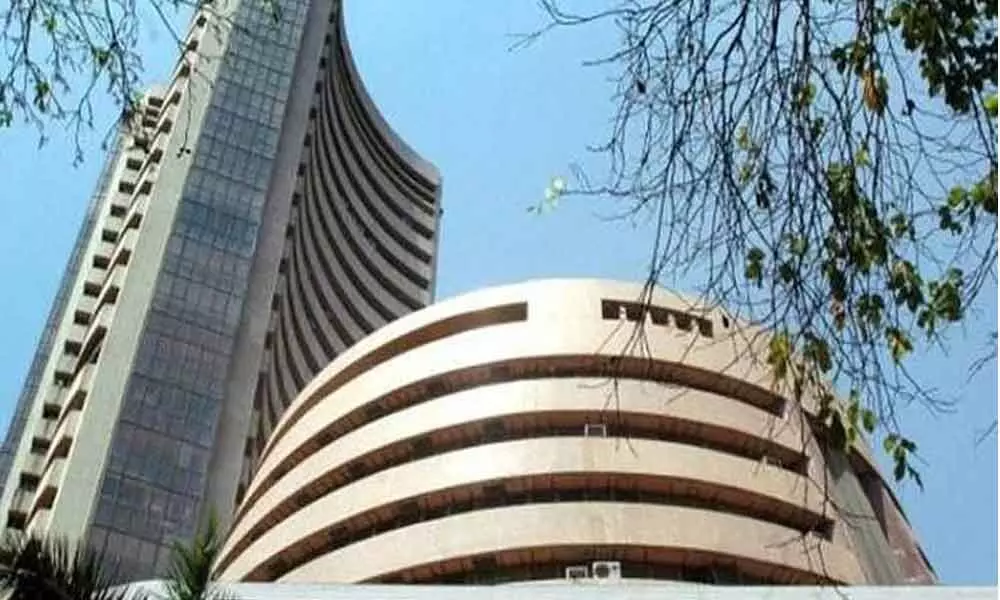US recession fears casting shadow on bourses

US recession fears casting shadow on bourses
Stock-specific volatility ahead of the start of the quarterly earnings season week; US markets will be closed Monday for July 4th
Amidst uncertainty and volatility, the domestic stock markets remained in consolidation phase during the week ended and posted marginal gains. For the week, BSE Sensex was up 179.95 points (0.34 percent) to close at 52,907.93, while NSE Nifty was up 52.75 points (0.33 percent) to end at 15,752 level. The BSE Mid-cap Index and the BSE Small-cap index were up by 0.26 percent and one percent respectively. However, in June, Sensex lost 4.5 percent and Nifty shed 4.8 percent. On the sectoral front, the Nifty FMCG index rose 2.5 percent, and Metal and Realty indices added 2 percent each. On the other hand, Nifty Consumer Durables, Oil & Gas and PSU
Bank indices down 0.5-1 percent. FIIs sold equities worth Rs58,112.37 crore during June. Also, it is pertinent to understand that the large short positions from FIIs are highest ever in history of India's derivatives markets.
Any positive development like cease fire on Russia-Ukraine war front or a rally in global markets after recent slump can result in sharp short covering rally in Indian derivative markets. The fall in the rupee continued this week also as it surpassed the 79 mark for the first time and touched fresh record low of 79.11. The INR lost 70 paise to end at 79.04 per dollar on July 1 against its June 24 closing of 78.34. Buoyancy in economy was reflected in the GST collections of nearly Rs1.45 lakh crore for the month of June as against Rs1.4 lakh crore in May. The monsoon, critical for farm output and economic growth covered the entire country, six days earlier than usual, but rain totals are five per cent below average so far this season says IMD. US markets have fallen for 11 of the past 13 weeks, the 'worst first half of the year' since 1970. It is important to understand that when defensive sectors start outperforming more economically sensitive sectors, it indicates that investors are focused on the growing risk of a recession relative to a soft landing. US Fed Chairman Jerome Powell continued to say that he was more concerned about failing to stamp out high inflation than the possibility of raising interest rates too much and having the economy go into a downturn. US markets will be closed Monday for the Fourth of July. On the home front, in the week ahead, stock markets would be driven by domestic macroeconomic data, global trends, crude oil movement and FII activity. Expect stock specific volatility ahead of the start of the quarterly earnings season.
Listening Post: Crypto's Domino Effect Is Widening, Threatening More Pain. Turmoil in the digital-assets ecosystem has grown in recent weeks, with losses in cryptocurrencies blowing holes in balance sheets and pushing firms near bankruptcy. Digital asset prices have been falling
dramatically along with other speculative bets in response to the Federal Reserve's move to raise interest rates. Crypto's headache intensified in May, when the stablecoin TerraUSD broke from its dollar peg and dragged the value of its sister cryptocurrency Luna down with it, eradicating $40 billion. Crypto still exists largely outside of regulation, with few federal laws specific to crypto and the SEC and other regulators across the globe taking up cases against individual firms on an ad hoc basis. After a pair of cryptocurrencies crashed, wiping out billions of dollars in value in May, a British Virgin Islands court this past week ordered a hedge fund that had survived several crypto downturns to liquidate. Some observers are drawing parallels between the current leverage-fuelled carnage in crypto and the 1998 blowup of Long-Term Capital Management, a heavily leveraged hedge fund whose collapse sparked concern of contagion in the financial system. The growth of the industry—worth more than $3 trillion at its peak last year—has surpassed the ability of regulators to keep up, according to analysts. The blow up of TerraUSD prompted renewed calls for legislative regulation covering crypto. For now, executives in the industry are hoping the current crisis is a repeat of the 'crypto winter' in 2018, during which the bad actors who orchestrated the boom and bust of initial coin offerings were flushed out, making the system stronger as a result.
Quote of the week: "The four most dangerous words in investing are, it's different this time — Sir John Templeton Follow market trends and history. Don't speculate that this particular time will be any different. For example, a major key to investing in a specific stock or bond fund is its performance over five years
F&O /Sector watch
Settlement week witnessed brisk, but range-bound trading in the derivatives segment. True to predictions, stock-specific volatility continued to be very high. Beginning of July series saw the Nifty futures Open Interest (OI) at 1.28 crore shares which is still far lower compared to the last 15-year average OI of 2.2 crore shares. Also, rollovers in Nifty futures declined at 75 per cent (compared to last month 79%) and well below 3-month average of 80 per cent. The Nifty has ended the third consecutive expiry in losses with the June series registering a loss of 2.41 percent. It is pertinent to observe that after touching a low of 15183 level at the start of the series, it recovered by almost 700 points by the end of the series. Most of the fall in the Nifty is contributed by metals, pharma and realty sectors. After outperformance in the last two series, Bank Nifty underperformed for the June series. Maximum OI in the Nifty monthly Put options (28 July expiry) is at 15,000 strike (26.33 lakh shares) and maximum OI in Call options (28 July expiry) is at 16,500 (19.86 Lakh shares) followed by 17,000 (19.70 lakh shares). In the Bank Nifty highest Call OI concentration is at 34000 strike whereas on Put side, it is at 33000 strike. Implied Volatility (IV) of Calls closed at 21.37 per cent, while that for Put options, it closed at 22.59. The Nifty VIX for the week closed at 21.84 per cent.
PCR of OI for the week closed at 1.28 higher than the previous week. Techies say oscillators are quite oversold and markets are poised for a strong short covering bounce. To regulate prices and maintain the stock of petroleum products in the domestic market, the government increased the export duty on petrol, diesel, and aviation turbine fuel. The move comes after over a week of the government bringing all petrol pumps under universal service obligation to ensure fuel availability. The move triggered sharp fall in ONGC and RIL on Friday. Industry sources do not expect the move to trigger weakness in the sector akin to what happened to Steel companies earlier. Impact is likely to be knee jerking short one. Alarming is the report of the JPMorgan Chase & Co. warning that global oil prices could reach a 'stratospheric' $380 a barrel if US and European penalties prompt Russia to inflict retaliatory crude-output cuts. With the semiconductor situation showing signs of easing, monthly auto sales numbers have again started showing a positive trend. The market for commercial vehicles has been boosted by pent-up demand, firming freight rates, and an increase in infrastructure activity. The two-wheeler space is the only one that has not recovered yet as the demand for weddings is declining by 10 to 15 percent month over month. Stay overweight on the sector. Stock futures looking good are Axis Bank, Britannia, DLF, Federal Bank, Havells India, ITC and Oberoi Realty. Stock futures looking weak are Aurobindo Pharma, AU Bank, Bajaj Auto, Delta Corp, Lupin, Sun TV and Ultratech Cement.


















